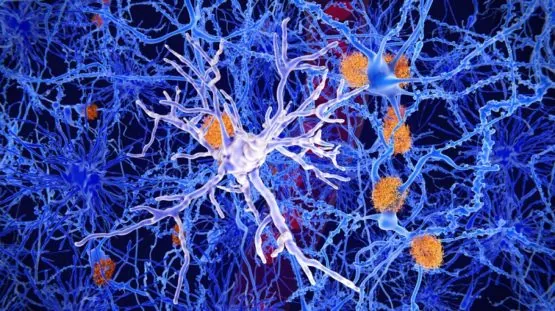Scientists have successfully reprogrammed astrocytes (a type of brain cell) into healthy neurons in the brains of living mice. This technique could potentially be used for replenishing the neuronal population in people suffering from brain damage and age-related cognitive decline [1].
Cellular fate is not sealed
Back in 2006, a group of scientists led by Shinya Yamanaka developed a technique for reprogramming somatic cells back into pluripotent stem cells. The technique introduces four pluripotency-associated transcription factors into the cells. This “cocktail” of four genes became known as Yamanaka factors, and its creators received a Nobel Prize.
Later, other researchers proved that similar results can be achieved by using small molecules rather than proteins [2]. Reprogramming using small molecules is much safer, since it neither triggers an immune reaction nor disrupts the cell’s proteostasis (protein balance). In recent years, several cocktails of small molecules have been formulated for various influences on cellular fate.
The potential implications of cellular reprogramming are enormous. In humans and other mammals, regeneration ability is nothing to boast about, and it is even poorer in certain organs, such as the brain; new neurons can form in the brain but only in certain regions and modest numbers. Cellular reprogramming can be used to create neurons from other types of resident brain cells, such as astrocytes. This might be a game-changer in treating age-related cognitive decline, as cognitive capacity is strongly related to neuron number and function [3].
Let there be neurons
Astrocytes, called such for their star-like shape, are brain cells tasked with various maintenance jobs. Astrocytes are so abundant that they outnumber neurons five to one. They are close relatives of neurons and share many morphological and chemical properties with them, which makes them perfect candidates for conversion into neurons, especially in vivo.
The authors of this paper had previously experimented with the small-molecule cocktail of Forskolin, ISX9, CHIR99021, and I-BET151 (FICB) to reprogram fibroblasts into functional neurons in vitro. This time, after tweaking the cocktail to increase efficiency, the researchers tried creating neurons from astrocytes in vitro and then in vivo. According to the paper, in vivo reprogramming circumvents various challenges that are typical for in vitro reprogramming and consequent transplantation – such as cell purification, long-term cell survival, and integration into the host tissue.
The experiments involved treating adult mice with the cocktail for two weeks. Upon completion of the treatment, the researchers confirmed that a considerable number of new neurons had been formed, although conversion rates varied depending on which part of the brain had been treated.
Healthy and well-connected
It took many additional tests to confirm the success and address all the concerns. The researchers analyzed the morphology and genetic expression patterns of the newly formed cells to prove that these were indeed neurons formed from resident astrocytes. They were able to confirm that these neurons were fully functional by testing their electrophysiological properties – the ability to create and propagate electric currents in a neuron-like fashion.
Moreover, the scientists showed that the new neurons had established synaptic connections to endogenous neurons to become fully integrated and operational parts of the brain. This was achieved via a technique called retrograde tracing, which involves infecting neurons with a virus that only transmits between neurons via their synaptic connections, such as rabies or pseudorabies.
Neurons in various parts of the brain differ slightly, and these differences are functionally important. The researchers were excited to discover that CiNs (chemically induced neurons) displayed these region-specific properties. They speculate that the population of endogenous neurons might have guided the process of conversion towards region-specific phenotypes in what can be called neuronal peer pressure.
The researchers admit that many challenges remain before this intervention can become a therapy at your local clinic, including the development of a viable delivery strategy. They put their hopes in new techniques such as nanocarriers, which potentially can achieve sustained drug release after a single injection. Since neurons are notoriously long-lived, it would be interesting to know whether CiNs’ lifespan in humans is comparable to that of regular neurons.
Conclusion
This technique of creating chemically induced neurons from resident astrocytes in vivo can be a milestone in the fight against neuronal loss, a hallmark of age-related cognitive decline. While the brain, with its poor regenerative abilities, is a natural target for cellular reprogramming in vivo, we can also expect more research in other tissues that are prone to age-related degeneration.
Literature
[1] Ma, Y., Xie, H., Du, X., Wang, L., Jin, X., Zhang, Q., … & Deng, H. (2021). In vivo chemical reprogramming of astrocytes into neurons. Cell discovery, 7(1), 1-13.
[2] Kim, Y., Jeong, J., & Choi, D. (2020). Small-molecule-mediated reprogramming: a silver lining for regenerative medicine. Experimental & molecular medicine, 52(2), 213-226.
[3] Avila, J., Llorens-Martín, M., Pallas-Bazarra, N., Bolós, M., Perea, J. R., Rodríguez-Matellán, A., & Hernández, F. (2017). Cognitive decline in neuronal aging and Alzheimer’s disease: role of NMDA receptors and associated proteins. Frontiers in neuroscience, 11, 626.




